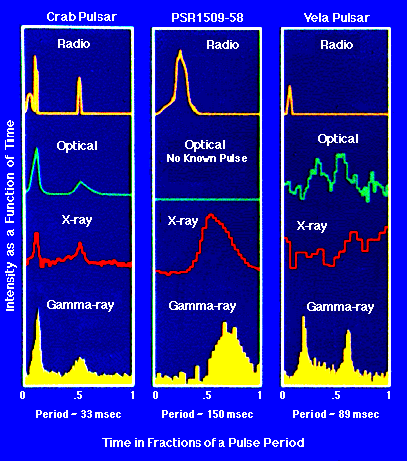Pulsars
A pulsar is a
neutron
star which emits beams of radiation that sweep through the
earth's line of sight.
Like a
black hole, it
is an endpoint to stellar evolution. The "pulses" of high-energy
radiation
we see from a pulsar are due to a misalignment of the neutron star's
rotation axis and its magnetic axis. Pulsars pulse because the rotation of the neutron star
causes the radiation generated within the magnetic field to sweep in
and out of our line of sight with a regular period.

A diagram of a pulsar showing its rotation axis,
its magnetic axis, and its magnetic field.
Observations of Pulsars
Neutron stars have very intense
magnetic
fields, about 1,000,000,000,000
times stronger than Earth's own field. However, the axis of the magnetic field is not
aligned with the neutron star's rotation axis.
The combination of this strong magnetic field and the rapid rotation
of the neutron star produces extremely powerful electric fields, with
electric potential in excess of 1,000,000,000,000 volts.
Electrons
are accelerated to high velocities by these strong electric fields.
These high-energy electrons produce radiation (light) in two general
ways: (1) Acting as a coherent plasma, the electrons work together to
produce radio emission by a process whose details remain poorly
understood; and (2) Acting individually, the electrons interact with
photons or the magnetic field to produce high-energy emission such as
optical,
X-ray and
gamma-ray. The exact locations where the
radiation is produced are uncertain and may be different for different
types of radiation, but they must occur somewhere above the magnetic poles.
External viewers see pulses of radiation whenever this region above
the the magnetic pole is
visible. Because of the rotation of the pulsar, the pulses thus appear much
as a distant observer sees a lighthouse appear to blink as its beam
rotates. The pulses come at the same rate as the rotation of the neutron
star, and, thus, appear periodic.
Gamma-ray Pulsars
Pulsars are the original gamma-ray astronomy point sources. A few years
after the discovery of pulsars by radio astronomers, the Crab and Vela
pulsars were detected at gamma-ray energies. Pulsars accelerate particles
to tremendous energies in their magnetospheres. These particles are ultimately responsible for
the gamma-ray emission seen from pulsars.
By the end of 2004 there were about 1500 pulsars known through
radio detections, but only
seven had been detected in the gamma-rays. Gamma-ray telescopes
preferentially detect young, nearby pulsars. These pulsars
tend to have large magnetic fields and to be spinning rapidly. It is
the loss of the pulsar's spin energy which eventually appears as radiation
across the electromagnetic
spectrum, including gamma-rays. Both observations
and models indicate that pulsars eventually lose the ability to emit
gamma-rays as the pulsar slowly takes longer and longer to rotate.

|
The folded light curves of some of the known gamma-ray pulsars compared
to other energies. Explaining the differences is an important part
of pulsar studies.
|
Gamma-ray astronomers measure both the pulsar's light curve and how the gamma-ray energy
is distributed within the light curve. In this way, detailed models of how
this light is created can be compared to observations in order to better
understand pulsars. In addition, comparison of the
gamma-ray energy to energy emitted at other wavelengths gives scientists
other important clues to how the radiation is created. Hopefully,
future gamma-ray instruments will greatly increase the number of
detected sources and allow astronomers greater insight into these
fascinating objects.

|
The pulsed emission from Geminga, formerly an unidentified gamma-ray
source. In the bottom set of images, the region of the sky containing
Geminga is shown as a function of pulsar phase.
|
X-ray Pulsars
Although all pulsars are neutron stars, not all pulsars shine in the
same way. X-ray pulsars in particular illustrate several ways in
which pulsar emission can originate:
- Magnetospheric Emission: Like gamma-ray pulsars, X-ray pulsars can
be produced when high-energy electrons interact in the magnetic field
regions above the neutron star magnetic poles. Pulsars seen this way,
whether in the radio, optical, X-ray, or gamma-ray, are often referred
to as "spin-powered pulsars," because the ultimate source of energy
comes from the neutron star rotation. The loss of rotational energy
results in a slowing of the pulsar spin period.
- Cooling Neutron Stars: When a neutron star is first formed
in a supernova, its surface is extremely hot (more than 1,000,000,000
degrees). Over time, the surface cools. While the surface is still
hot enough, it can be seen with X-ray telescopes. If some parts of
the neutron star are hotter than others (such as the magnetic poles),
then pulses of thermal X-rays from the neutron star surface can be
seen as the hot spots pass through our line of sight. Some pulsars,
including Geminga (see above), show both thermal and magnetospheric
pulses.
- Accretion: If a neutron star is in a binary system with a
normal star, the powerful gravitational field of the neutron star can
pull material from the surface of the normal star. As this material
spirals around the neutron star, it is funneled by the magnetic field
toward the neutron star magnetic poles. In the process, the material
is heated until it becomes hot enough to radiate X-rays. As the
neutron star spins, these hot regions pass through the line of sight
from the Earth and X-ray telescopes see these as X-ray
pulsars. Because the gravitational pull on the material is the basic
source of energy for this emission, these are often called "accretion
powered pulsars."
Last Modified: December 2006
|